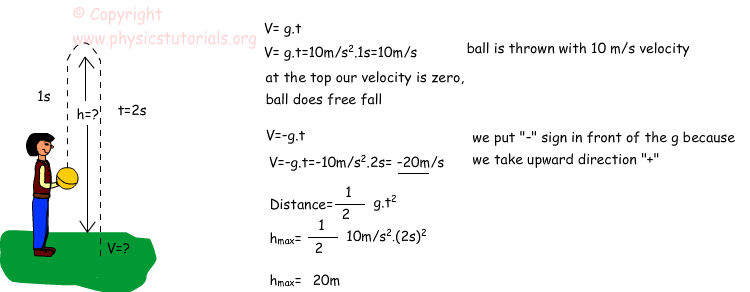Introduction to Free Fall
A free falling object is an object that is falling under the sole influence of gravity. Any object that is being acted upon only by the force of gravity is said to be in a state offree fall. There are two important motion characteristics that are true of free-falling objects:
- Free-falling objects do not encounter air resistance.
- All free-falling objects (on Earth) accelerate downwards at a rate of 9.8 m/s/s (often approximated as 10 m/s/s for back-of-the-envelope calculations)
 Because free-falling objects are accelerating downwards at a rate of 9.8 m/s/s, a ticker tape trace or dot diagram of its motion would depict an acceleration. The dot diagram at the right depicts the acceleration of a free-falling object. The position of the object at regular time intervals - say, every 0.1 second - is shown. The fact that the distance that the object travels every interval of time is increasing is a sure sign that the ball is speeding up as it falls downward.
Because free-falling objects are accelerating downwards at a rate of 9.8 m/s/s, a ticker tape trace or dot diagram of its motion would depict an acceleration. The dot diagram at the right depicts the acceleration of a free-falling object. The position of the object at regular time intervals - say, every 0.1 second - is shown. The fact that the distance that the object travels every interval of time is increasing is a sure sign that the ball is speeding up as it falls downward.Free-fall acceleration is often witnessed in a physics classroom by means of an ever-popular strobe light demonstration. The room is darkened and a jug full of water is connected by a tube to a medicine dropper. The dropper drips water and the strobe illuminates the falling droplets at a regular rate - say once every 0.2 seconds. Instead of seeing a stream of water free-falling from the medicine dropper, several consecutive drops with increasing separation distance are seen. The pattern of drops resembles the dot diagram shown in the graphic at the right.
The kinematic equations are a set of four equations that can be utilized to predict unknown information about an object's motion if other information is known. The equations can be utilized for any motion that can be described as being either a constant velocity motion (an acceleration of 0 m/s/s) or a constant acceleration motion. They can never be used over any time period during which the acceleration is changing. Each of the kinematic equations include four variables. If the values of three of the four variables are known, then the value of the fourth variable can be calculated. In this manner, the kinematic equations provide a useful means of predicting information about an object's motion if other information is known. For example, if the acceleration value and the initial and final velocity values of a skidding car is known, then the displacement of the car and the time can be predicted using the kinematic equations.
Kinematic Equations and Free Fall
As mentioned, a free-falling object is an object that is falling under the sole influence of gravity. That is to say that any object that is moving and being acted upon only be the force of gravity is said to be "in a state of free fall." Such an object will experience a downward acceleration of 9.8 m/s/s. Whether the object is falling downward or rising upward towards its peak, if it is under the sole influence of gravity, then its acceleration value is 9.8 m/s/s.
Like any moving object, the motion of an object in free fall can be described by four kinematic equations. The kinematic equations that describe any object's motion are:

The symbols in the above equation have a specific meaning: the symbol d stands for the displacement; the symbol tstands for the time; the symbol a stands for the acceleration of the object (gravitational acceleration: -9.8m/s/s); the symbol vi stands for the initial velocity value; and the symbol vf stands for the final velocity.
There are a few conceptual characteristics of free fall motion that will be of value when using the equations to analyze free fall motion. These concepts are described as follows:
- An object in free fall experiences an acceleration of -9.8 m/s/s. (The - sign indicates a downward acceleration.) Whether explicitly stated or not, the value of the acceleration in the kinematic equations is -9.8 m/s/s for any freely falling object.
- If an object is merely dropped (as opposed to being thrown) from an elevated height, then the initial velocity of the object is 0 m/s.
- If an object is projected upwards in a perfectly vertical direction, then it will slow down as it rises upward. The instant at which it reaches the peak of its trajectory, its velocity is 0 m/s. This value can be used as one of the motion parameters in the kinematic equations; for example, the final velocity (vf) after traveling to the peak would be assigned a value of 0 m/s.
- If an object is projected upwards in a perfectly vertical direction, then the velocity at which it is projected is equal in magnitude and opposite in sign to the velocity that it has when it returns to the same height. That is, a ball projected vertically with an upward velocity of +30 m/s will have a downward velocity of -30 m/s when it returns to the same height.
These four principles and the four kinematic equations can be combined to solve problems involving the motion of free falling objects.
Graphs of how the position, velocity, and acceleration of objects under free fall motion change in time follow.
 |
 |
 |
Problems :)
Example The boy drops the ball from a roof of the house which takes 3 seconds to hit the ground. Calculate the velocity before the ball crashes to the ground. (g=10m/s² (9.8m/s² )

Velocity is;
V=g.t
V=10m/ s².3s=30m/s
We have learned how to find the velocity of the object at a given time. Now we will learn how to find the distance taken during the motion. I give some equations to calculate distance and other quantities. Galileo found an equation for distance from his experiments.
This equation is;

Using this equation we can find the height of the house in given example above. Let’s found how height the ball has been dropped? We use 10 m/s² for g.

I think the formula now a little bit clearer in your mind. We will solve more problems related to this topic. Now, think that if I throw the ball straight upward with an initial velocity. When it stops and falls back to the ground? We answer these questions now.

Picture shows the magnitudes of velocity at the bottom and at the top. As you can see the ball is thrown upward with an initial v velocity, at the top it’s velocity becomes zero and it changes it’s direction and starts to fall down which is free fall. Finally at the bottom before the crash it reaches its maximum speed which shown as V’. We have talked about the amount of increase in the velocity in free fall. It increases 9,8m/s in each second due to the gravitational acceleration. In this case, there is also g but the ball’s direction is upward; so the sign of g is negative. Thus, our velocity decreases in 9,8m/s in each second until the velocity becomes zero. At the top, because of the zero velocity, the ball changes its direction and starts to free fall. Before solving problems I want to give the graphs of free fall motion.

As you see in the graphs our velocity is linearly increases with an acceleration “g”, second graphs tells us that acceleration is constant at 9,8m/s², and finally third graphic is the representation of change in our position. At the beginning we have a positive displacement and as the time passes it decreases and finally becomes zero. Now we can solve problems using these graphs and explanations.
Example John throws the ball straight upward and after 1 second it reaches its maximum height then it does free fall motion which takes 2 seconds. Calculate the maximum height and velocity of the ball before it crashes the ground. (g=10m/s²)

Walang komento:
Mag-post ng isang Komento